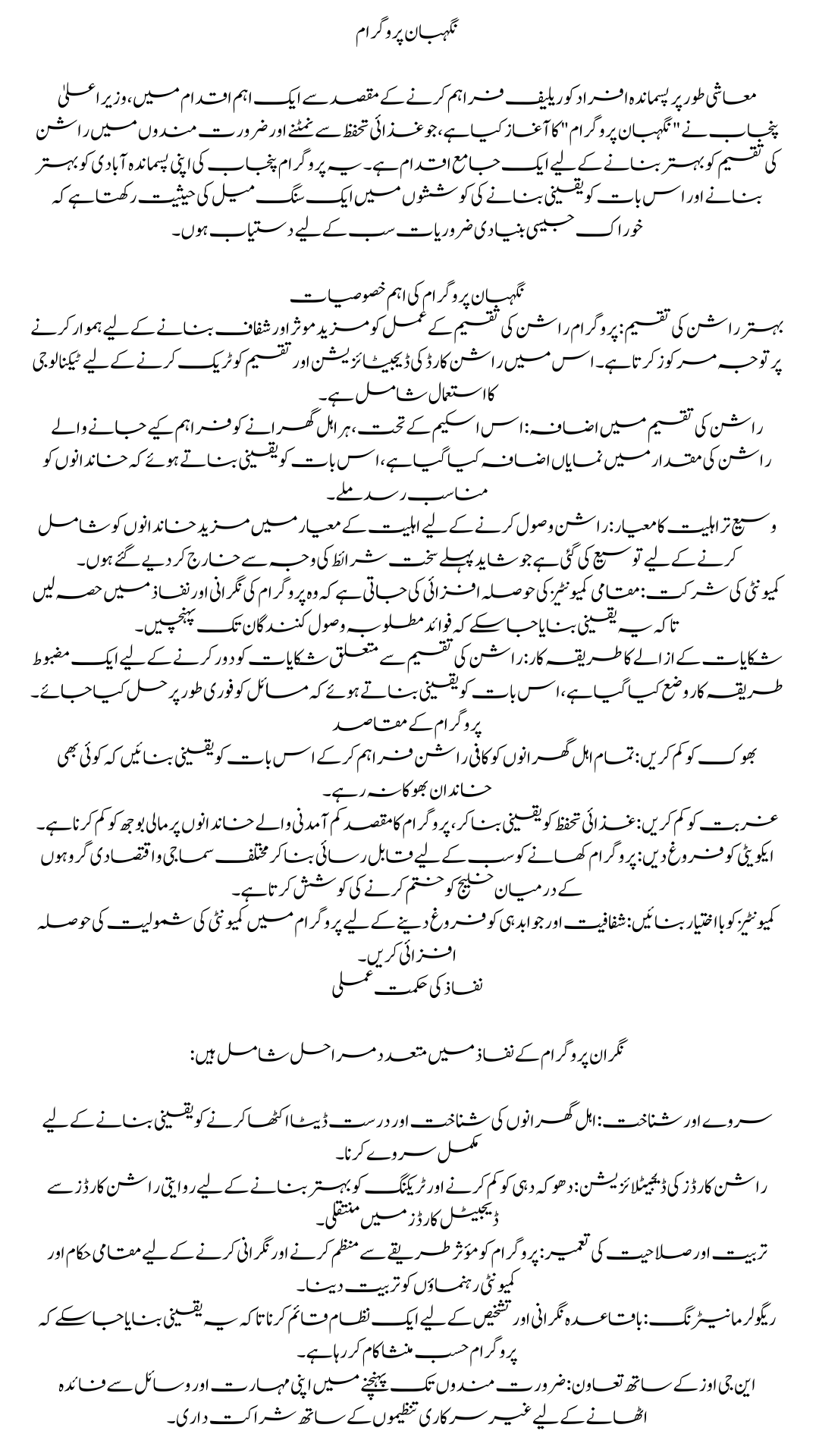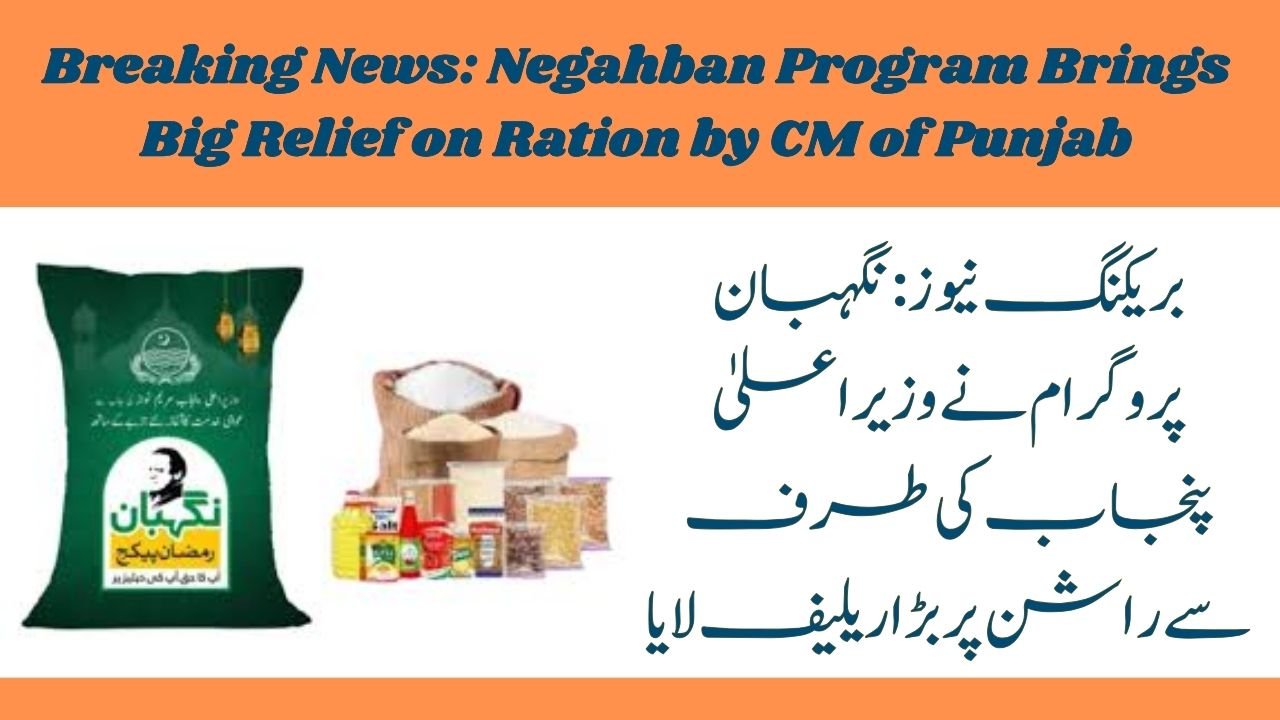Nigehban Program
In a significant move aimed at providing relief to the economically disadvantaged, the Chief Minister of Punjab has launched the “Nigehban Program,” a comprehensive initiative to address food security and improve the distribution of ration to the needy. This program marks a milestone in Punjab’s efforts to uplift its underprivileged population and ensure that basic necessities like food are accessible to all.
Key Features of the Negahban Program
- Enhanced Ration Distribution: The program focuses on streamlining the ration distribution process to make it more efficient and transparent. This includes the digitization of ration cards and the use of technology to track distribution.
- Increased Ration Allocations: Under this scheme, the quantity of ration provided to each eligible household has been increased significantly, ensuring that families receive adequate supplies.
- Wider Eligibility Criteria: The eligibility criteria for receiving ration have been expanded to include more families who may have been previously excluded due to stringent conditions.
- Community Participation: Local communities are encouraged to participate in the monitoring and implementation of the program to ensure that the benefits reach the intended recipients.
- Grievance Redressal Mechanism: A robust mechanism has been put in place to address grievances related to ration distribution, ensuring that issues are resolved promptly.
Objectives of the Program
- Alleviate Hunger: Ensure that no family goes hungry by providing sufficient ration to all eligible households.
- Reduce Poverty: By ensuring food security, the program aims to reduce the financial burden on low-income families.
- Promote Equity: The program seeks to bridge the gap between different socio-economic groups by making food accessible to all.
- Empower Communities: Encourage community involvement in the program to promote transparency and accountability.
Implementation Strategy
The implementation of the Negahban Program involves multiple steps:
- Survey and Identification: Conducting thorough surveys to identify eligible households and ensure accurate data collection.
- Digitization of Ration Cards: Transitioning from traditional ration cards to digital ones to minimize fraud and improve tracking.
- Training and Capacity Building: Training local officials and community leaders to effectively manage and monitor the program.
- Regular Monitoring: Establishing a system for regular monitoring and evaluation to ensure the program is functioning as intended.
- Collaboration with NGOs: Partnering with non-governmental organizations to leverage their expertise and resources in reaching out to the needy.

Expected Impact
The Nigehban Program is expected to have a profound impact on the socio-economic landscape of Punjab:
- Improved Nutrition: With better access to food, the nutritional status of low-income families is expected to improve.
- Economic Stability: Families will have more disposable income to spend on other necessities, contributing to overall economic stability.
- Social Harmony: By addressing basic needs, the program aims to reduce social tensions and promote harmony among different communities.
Frequently Asked Questions (FAQs)
1. What is the Negahban Program?
The Negahban Program is a government initiative launched by the Chief Minister of Punjab to improve the distribution of ration and ensure food security for economically disadvantaged families.
2. Who is eligible for the Negahban Program?
Eligibility criteria have been broadened to include more families. Generally, households with low income, those affected by unemployment, or those facing significant financial hardships are eligible. Detailed criteria will be provided by local authorities.
3. How can I apply for the Negahban Program?
Eligible individuals can apply through local government offices, online portals, or community centers designated by the government. The process involves submitting necessary identification and income proof documents.
4. What types of ration will be provided under this program?
The ration provided includes staple foods such as rice, wheat, pulses, cooking oil, and sugar, along with other essential items that ensure a balanced diet.
5. How will the ration be distributed?
Ration will be distributed through designated Fair Price Shops and community centers. The distribution process will be monitored using digital systems to ensure transparency.
6. How is the Negahban Program different from previous ration schemes?
The Negahban Program incorporates advanced technology for tracking and monitoring, has increased ration allocations, and expanded eligibility criteria, making it more inclusive and efficient than previous schemes.
7. What measures are in place to prevent corruption and ensure transparency?
The program uses digitized ration cards, regular audits, and community participation to minimize corruption. A grievance redressal mechanism is also in place to address any issues.
8. How can I report a problem or lodge a complaint?
Complaints can be lodged through a dedicated helpline, online portal, or at local government offices. There is a robust grievance redressal system to ensure that issues are addressed promptly.
9. How will the program be monitored?
The program will be monitored through regular audits, community feedback, and the use of digital tracking systems. Independent agencies may also be involved in the evaluation process.
10. What role do community members play in this program?
Community members are encouraged to participate in the monitoring and implementation of the program. Their involvement helps in ensuring that the benefits reach the intended recipients and enhances transparency.
11. Are there any special provisions for vulnerable groups?
Yes, the program includes special provisions for vulnerable groups such as the elderly, disabled, and single-parent households to ensure they receive adequate support.
12. How long will the Negahban Program run?
The program is intended to be a long-term initiative, with periodic reviews and adjustments based on its effectiveness and the evolving needs of the population.
13. What is the role of NGOs in the Negahban Program?
NGOs play a crucial role in identifying beneficiaries, distributing ration, and monitoring the program. They also assist in community outreach and education efforts.
14. Can beneficiaries track their ration allocation?
Yes, beneficiaries can track their ration allocation through a mobile app or online portal provided by the government, which ensures transparency and accountability.
15. How is the funding for the Negahban Program secured?
The funding for the program comes from the state government’s budget, with potential additional support from federal schemes and international aid organizations.
16. What are the long-term goals of the Negahban Program?
The long-term goals include achieving food security for all, reducing poverty, improving public health through better nutrition, and fostering social equity and community empowerment.
17. How does the program address rural and urban differences?
The program is designed to cater to both rural and urban populations, with specific strategies to address the unique challenges faced by each group. This includes tailored distribution channels and support mechanisms.
18. What steps are taken to ensure the quality of the ration provided?
The government ensures that all ration items meet the quality standards set by relevant authorities. Regular checks and audits are conducted to maintain the quality of the supplies.
19. How does the program align with other state and national initiatives?
The Negahban Program is aligned with other state and national initiatives focused on poverty alleviation and food security, ensuring a cohesive approach to addressing these issues.
20. What is the expected outcome of the Negahban Program?
The expected outcome is a significant reduction in hunger and poverty, improved nutrition and health among beneficiaries, and greater social equity and community involvement in governance.
Conclusion
The Nigehban Program represents a landmark initiative by the Punjab government to tackle food insecurity and provide much-needed relief to the state’s underprivileged population. With its comprehensive approach, involving enhanced ration distribution, broader eligibility, and community participation, the program is poised to make a substantial positive impact on the lives of many families. By addressing basic needs and promoting social equity, the Negahban Program is a crucial step towards building a more inclusive and resilient society in Punjab.
